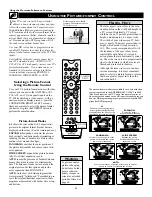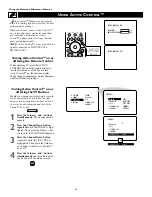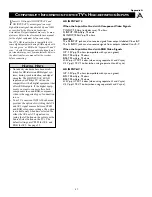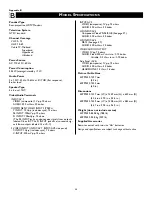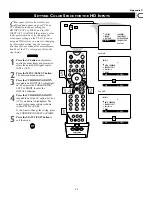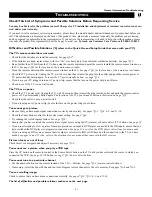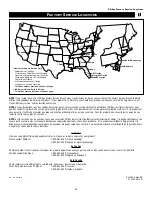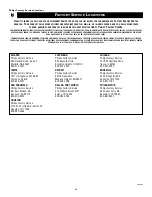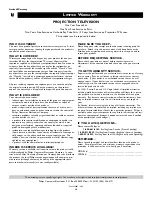
60
C
ARE AND
C
LEANING
General Information: Care and Cleaning
WARNING Concerning Stationary Images on
the TV Screen:
Do not leave picture border bars or stationary
images on screen for extended periods of time.
This can cause uneven picture-tube aging.
Normal use of the TV should involve the showing of pictures
that contain constantly moving and changing images that fill the
screen. Be careful not to leave nonmoving images on screen for
extended periods of time, or to display the same images on
screen too frequently, because subtle ghost images can be left
on the picture tubes. Avoid showing pictures with border bars or
the same stationary images more than 15 percent of your total
viewing in any one week. Sources of stationary images may be
broadcast channels, cable channels, satellite channels, digital
television boxes, DVD discs, laser discs, video games, CD-i
discs, videotapes, and others. Here are some examples of sta-
tionary images (this is not an all-inclusive list; you may
encounter others in your viewing):
• Border bars—solid bars shown when viewing a standard
(4:3) picture and some widescreen movies on your
widescreen (16:9) TV
• DVD menus—listings of DVD disc content
• Video-game images and scoreboards
• Television station logos—present a problem if they are
bright and stationary; moving or low-contrast graphics are
less likely to cause uneven aging of the picture tube
• Stock-market tickers—presented at the bottom of the TV
screen
• Shopping channel logos and pricing displays—bright and
shown constantly or repeatedly in the same location on the
TV screen.
All picture tubes age with use, with their light output diminish-
ing over time. But by maintaining normal use—mixing televi-
sion picture types—you will create conditions for the tubes to
age at an even rate. The result will be a TV picture that is even-
ly bright over the entire screen.
P
LACEMENT OF THE
TV
• To avoid cabinet warping, cabinet color changes, and
increased chance of set failure, do not place the TV where
temperatures can become excessively hot; for example, in
direct sunlight or near a heating appliance.
• Be sure to allow a free flow of air to and from the perforated
back cover of the set.
C
LEANING
• To avoid possible shock hazard, be sure the TV is unplugged
from the electrical outlet before cleaning.
• Regularly dust the TV with a dry, nonscratching duster to
keep the TV clean.
• When cleaning the TV, take care not to scratch or damage the
screen surface. Avoid wearing jewelry or using anything
abrasive. Do not use household cleaners. Wipe the front
screen with a clean cloth dampened with water. Use even,
easy, vertical strokes when cleaning.
Specially designed screen-cleaning kits are also available.
These kits contain anti-static cleaners and cloths designed to
get into the ridges of the TV screen. Purchase the kits at
stores that sell electronics. Or call our Customer Care Center
at 1-800-531-0039.
• Gently wipe the cabinet surfaces with a clean cloth or sponge
dampened in a solution of cool, clear water and a mild soap
or detergent. Use a clean, dry cloth to dry the wiped surfaces.
• Occasionally vacuum the ventilation holes or slots in the back
cover of the set.
• Never use thinners, insecticide sprays, or other chemicals on
or near the cabinet, as they might cause permanent marring of
the cabinet finish.
Summary of Contents for 55PP9352
Page 67: ...67 ...









